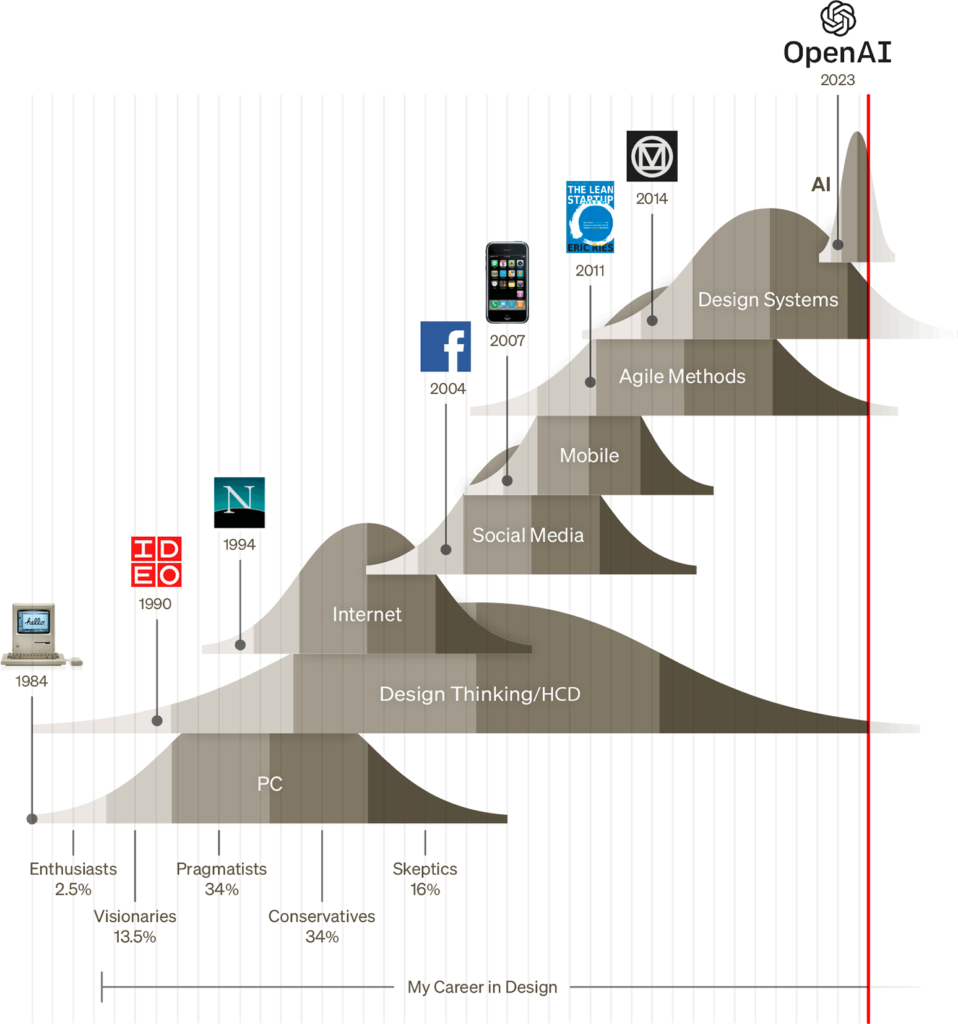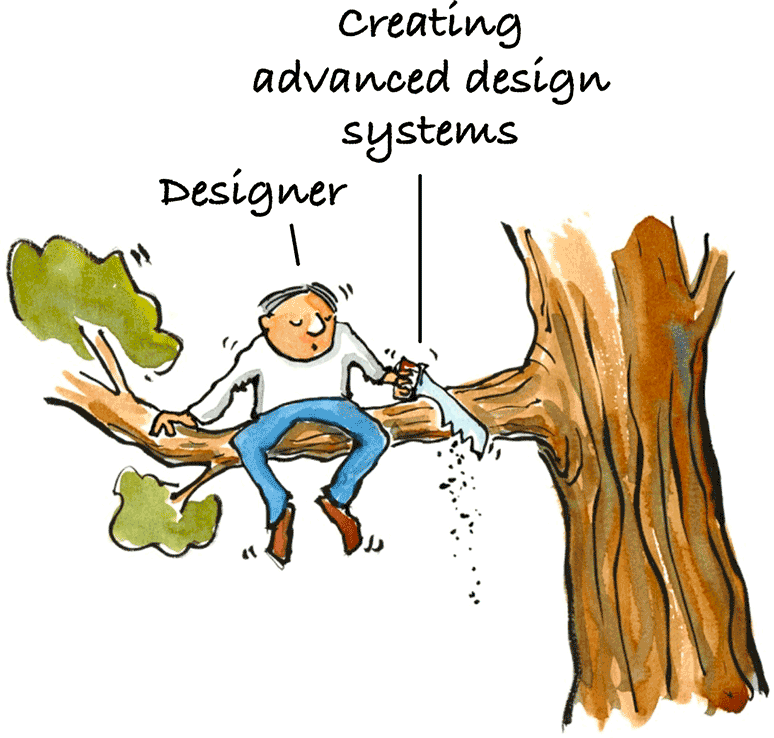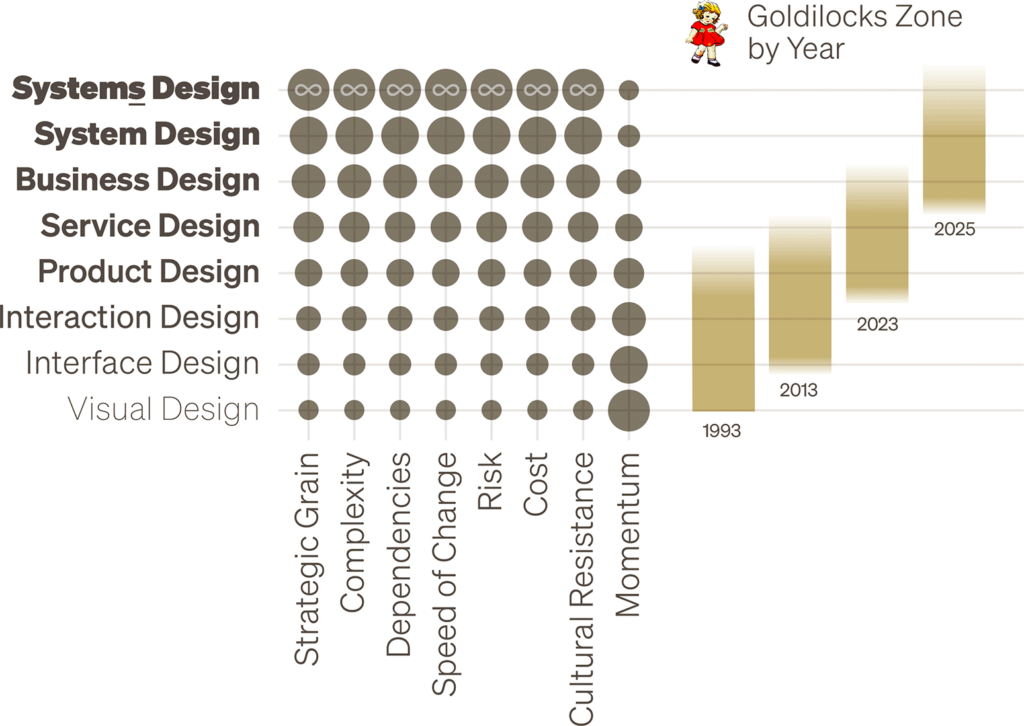Human-centered Design Meets Non-human ‘Intelligence’
The Explosive Entrance of AI
Let’s start by taking a moment to reflect on how astonishingly fast the development and adoption of generative AI has been relative to earlier transformative technologies and methods like:
• The PC (~25 years)
• The internet (~16 years)
• Social media (~14 years)
• Mobile devices (~12 years)
• Design thinking / Human-centered design (~36 years)
• Agile methodologies (~20 years), and
• Design systems (~12 years)
In his 1999 book, Consilience: The Unity of Knowledge, the biologist E.O. Wilson famously highlighted the imbalance between our “Paleolithic emotions, medieval institutions and godlike technology.” Twenty-five years on, his observation seems especially prescient as AI makes dazzling advancements with far-reaching implications while our societal structures appear mostly flat-footed.

Most of these past transformations felt very fast, many so fast that they outpaced our ability to foresee and mitigate the harms that would follow in their wake. AI is bursting onto the scene much more quickly. Fortunately, there are many smart and influential people thinking about the impact radius of the AI explosion and working to activate our social, economic, and governmental response. Much depends on their success.
Don’t get me wrong, I’m a techno-optimist who thought the call for a pause was as unwise as it was doomed. I believe technology is a huge net positive for our species and I’m confident that it will be central to any solutions we develop to address the daunting challenges of our time. I have jumped into AI with both feet but I strongly believe this latest revolution demands vigilance commensurate with its magnitude and blinding speed.
I recommend Brian Merchant’s outstanding book, Blood in the Machine: The Origins of the Rebellion Against Big Tech or at least his interview on 99% Invisible. I’ll never think of the term Luddite as pejorative again. For another dose of thoughtful counterhype, see Have We Reached Peak AI? By Ed Zitron.
Coming Soon: Self-driving Development and Design
5 months ago – an eternity in AI time – future-focused thought leader (and my former boss) T.A. McCann was telling us that natural language had become the world’s most powerful programming language. At about the same time, demo videos like How ChatGPT Built My App in Minutes were reminiscent of Sputnik in that they were rudimentary but served as a bellwether for where things were headed.
Fast forward to this morning’s news that Cognition AI is launching Devin, a far more sophisticated “AI software engineer” capable of wearing many hats simultaneously, skilling up on new technologies as needed, autonomously managing thousands of decision points, creating and training its own AI ‘minions’ to complete specialized subtasks, and delivering complete, thoroughly tested digital products and iterative refinements in near realtime.
In this context, the “AI Pair Programming” of Microsoft’s GitHub Copilot for Visual Studio starts looking like temporary human training wheels for what will soon be the fully, or at least mostly automated development of complex products and services.


So we’ll just tell our tools what capabilities we want and they’ll go off and build them. That’s cool but the finer points of how those capabilities get expressed as products and services for use by humans will remain the province of thoughtful human designers, right?… Right?
Weeell, there’s mounting evidence to suggest that self-driving design (desAIgn™) is hot on the heels of self-driving development.
The tools and processes most teams rely on to create products and services today were becoming much more efficient and integrated long before they all started sprouting genAI capabilities. Agile teams, working in sprints and informed by data-driven insights use tightly integrated tools like adaptive heuristics, advanced design systems, pattern libraries and increasingly powerful development frameworks. Additionally, process automation and a growing arsenal of personal productivity tools are helping us keep the accelerator mashed to the floor.
Despite all these efficiencies, any agile team member will tell you there’s still plenty of work to keep everyone very busy, especially as many teams are being squeezed to do more faster, with fewer people.

The tools and processes used by designers and developers have been converging for years and AI is kicking that convergence into high gear.
Design systems are getting much smarter. Their patterns and components are becoming more comprehensive, fine-grained, semantically rich, and expressed more rigorously, in ways that are increasingly readable and malleable by AI. This is happening within product ecosystems but also across them.
This means that, like development technologies, design elements, systems, interaction patterns, user flows, and entire product designs are becoming ripe for automation.
We’re plugging huge flows of data into these tools with an eye toward automating not only the creation of products and services but also their data-driven refinement over time.
John Maeda’s corny but informative talk with Ben Shepherd about AI-copiloted Design Thinking gives us a taste of how AI is already getting its GPUs around activities further upstream in the human-centered design process.
Organizations are viewing AI as corporate Ozempic as evidenced by tech layoffs continuing apace. Clearly, the plan is to do much more with many fewer people very soon.
The Uncounted Costs of Speed
About the time E.O. Wilson was pointing out how underequipped we were to wield our “godlike technology”, Bill Gates was promoting his dream of Business @ the Speed of Thought. In the 25 years since then, businesses have been prioritizing speed over squishier goals like quality, differentiation, or deep, thoughtful innovation. It might be more accurate to say that business has bought into the flawed dogma that increasing speed will somehow result in quality, differentiation, and innovation. When faced with the adage “Good, fast, cheap. Pick any two,” business has answered loudly and clearly, “Fast and cheap, please!”
If we zoom out and look at today’s constellation of tools and processes alongside tomorrow’s emerging trends, it’s clear that business is building a machine designed to wring out every drop of efficiency as cheaply as possible in pursuit of ever-greater speed. This cold logic dictates that anything that can be automated will be automated and AI promises to be the lynchpin of the machine by enabling the automation of, well, just about everything.
Companies finally seem poised to realize the dream of Business @ the Speed of Thought.

As a capitalist, I get it.
Moral judgements aside, this is just a new chapter in a story as old as business. It’s driven by the same basic forces as the industrial revolution, the postwar manufacturing boom, and every other gold rush since. I don’t think there are any diabolical architects at the heart of this trend, I just think this is what capitalism and its incentives look like at 10x/20x speed, for better and for worse.
As a productivity geek, I get it.
Efficiency is alluring because it promises to help us reclaim precious time for more rewarding or valuable activities. The big challenge will be to somehow reconcile what practitioners find rewarding and valuable (thoughtfulness, quality, balance) with what companies and shareholders find rewarding and valuable (more!, faster!).
As an experimenter, I get it.
A machine that lowers the cost of product design and development to near zero unlocks the ability to try a functionally limitless number of solutions. The challenge here will be cultivating the patience, discernment and restraint required to choose rather than just throwing all the spaghetti at the wall (the wall here being the market) to see what sticks.
As a humanist and designer, I’m deeply concerned.
Our digital world is being swamped by AI-generated articles, books, misinformation, deepfakes, fauxtographs, and more – always more. This tsunami is bewildering us and shaking our trust in things as fundamental as shared truth. I’m terrified to think what opening the taps on generative products and services might do.
On a longer timeline, I would be more bullish about our ability to respond but AI is rolling out into the world at an inhumane pace that our mammalian brains and societal immune response simply can’t handle.
Relax doomer. The market will sort it out. What’s the problem?
Most of these generated products will be weak
The inverse correlation between quantity and quality will be on full display as impatient companies release anemic MVPs (emphasis on the M) and data-driven iterations at a cadence we can scarcely imagine.


… and beige
Differentiation will also be sacrificed on the altar of speed as the design systems and data-fueled patterns that drive the generated user experience (GUX?) become increasingly standardized. The products built upon those systems and patterns are likely to revert to data-driven beigeness pretty quickly.
• The Age of Average
• Blanding: What Is It, How Did We Get Here & What Does it Mean Going Forward
• Why Does Every New Car Look Like Every Other New Car?
… and the sheer volume will overwhelm us
As with generated content today, it will become harder and harder to find the authentic, trustworthy, and valuable needles in the ever-growing haystack of mediocre and sometimes malicious products and services.
Of course, the skeleton crews tending the machines will still contain a few human designers working overtime turning whatever dials they can in an effort to imbue the output of the machines with the qualitative traits and uniquely human details that have “driven adoption” since the dawn of time.


Ok, but what will the rest of us do?



Those of us who either choose not to design and tend the machines or don’t have that option because the market is saturated have several options, One of which I find pretty inspiring.
Compete with the machines
This is probably a losing strategy over time. Like General Eric Shinseki said, “If you don’t like change, you’re going to like irrelevance a lot less.”
Serve an upmarket niche
Specialize in designing the few human-crafted luxury products for which the rich will probably always provide a market. Those gigs will be as scarce as land in Waterworld though so competition will be especially fierce.
Switch disciplines or even careers
This shift will make design a less compelling career path for some folks. Making a big switch is a perfectly valid response to change of this magnitude.
Practice design at a higher level than products and services
In my view, this is the way forward for most of us. I get the impression that many designers have been working on products and services for so long they have lost sight of the fact that, with a little reframing and retooling, their highly developed creative problem solving skills are transferrable to higher level contexts.
• Augment your established HCD superpowers with new strategy and systems thinking skills.
• Become a cyborg. Adopt and leverage AI and other emerging technologies to help you understand and design within the dizzying complexity and nuance of larger systems.
• Rebrand yourself to reflect the higher strategic altitude at which you now work.
The ‘Goldilocks Zone’ of Design is on the Move


AI seems set to automate much of product and service UX but it is also opening up exciting opportunities to scale design-led problem solving to bigger picture challenges like:
• The climate crisis
• Governance and regulation
• Energy systems
• Social & economic justice
• Societal/ideological divisions
• Misinformation/Disinformation/Content provenance
• Designing businesses and organizations that account for and address all of the above
This transition doesn’t need to be jarring, it can feel like a very natural progression. For example, my background is primarily in human-centered product and service UX design but these days, I spend a larger proportion of my time designing and integrating advanced design systems – a key part of the machines that will soon be designing those products and services.
I am also fortunate to have found my way to the proverbial ‘seat at the table’ where I increasingly get to apply HCD methods at the level of the businesses rather than just products. Now I look more like a strategy consultant who geeks out on systems thinking and happens to have a pretty deep HCD skillset.
My hope is that this climb to higher ‘altitudes’ will continue and accelerate. As our tools and techniques give us more leverage, designers will be empowered to innovate in ever larger contexts on behalf of our fellow humans and all the interrelated systems in which we live.
You may have heard the expression, “Turtles all the way down.” Well, I propose that we use all of our newfound power to kick off an era of Design all the way up.
Other Relevant Links
The State of UX in 2024 by UX Trends
The Big Design Freak-out by Robert Fabricant
Design Leaders Are in Their Reinvention Era by Robert Fabricant
Hey Designers, They’re Gaslighting You by Sara Wachter-Boettcher
Shift from “Product First” to “Product Last.” by Debbie Levitt
The 2024 Design in Tech Report by John Maeda
Thoughts?
Please add your thoughts and criticism to the comments on this LinkedIn post.
Thanks!
A huge shout out to my dear friends and colleagues who helped me wrangle these thoughts into something that I hope is provocative/informative/useful.
Patrick Sharbaugh, Katherine Augustine, Matt Cibelli, Charity Gourley, Siri Anderson
